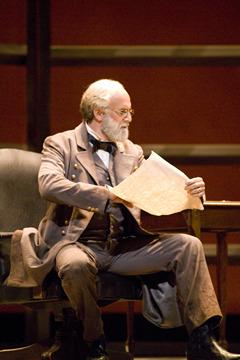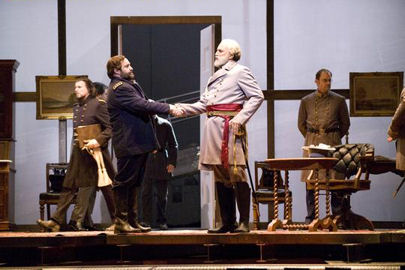Other Links
<Editorial Board
- Editor - Bill Kenny
- London Editor-Melanie Eskenazi
- Founder - Len Mullenger
Google Site Search
SEEN
AND HEARD INTERNATIONAL OPERA REVIEW
Philip Glass,
Appomattox:
San Francisco Opera, Dennis Russell Davies, conductor; War Memorial
Opera House, San Francisco. 14.10.2007 (HS)
Cast:
Robert E. Lee: Dwayne Croft /
There is a moment in
Appomattox,
the new opera by Philip Glass centered on the end of America's Civil
war, when the stage bursts with life. A regiment of African-American
soldiers fills the stage, and they sing a march, the original music
by Glass and a pastiche of period tunes such as "Battle Hymn of the
Republic," to a rousing text from the times. It is the climax of a
sequence depicting the taking of Richmond, the Confederate capitol,
by Union troops in 1865.
Act I tells the story of the taking of Richmond, first by focusing
on the two generals, then by scenes of citizens fleeing as bombs
explode around them, and the arrival of the soldiers. The scenes
from later in history come in Act II, set in the home where the
surrender was signed. Some allude to Lincoln's assassination, others
to Grant's presidency, the 1873 murder of 100 black men in Alabama
at the hands of the military, and the murder of Jimmy Lee and two
white civil rights workers in the 1960s. Despite the best intentions
of Grant and Lee at Appomattox for civility and grace, human nature
mostly argues otherwise.
Photos ©
Terrence McCarthy
Brian Leerhuber (10/24)
Ulysses S. Grant: Andrew Shore*
Julia Dent Grant: Rhoslyn Jones
Mary Custis Lee: Elza van den Heever
Mary Todd Lincoln: Heidi Melton
Elizabeth Keckley: Kendall Gladen
T. Morris Chester: Noah Stewart
Abraham Lincoln: Jeremy Galyon
Brig. Gen. Edward Alexander: Chad Shelton*
Julia Agnes Lee: Ji Young Yang
Edgar Ray Killen: Philip Skinner
Director
-
Robert Woodruff
Set designer
-
Riccardo Hernandez
Costumes
Paul Tazewell

Robert E. Lee - Dwayne Croft
In set pieces such as these, the opera soars. Moments earlier, a
black journalist seats himself in the speaker's chair from the ruins
of the Confederate legislature and narrates a dispatch for his
newspaper on the Northern triumph. After the South's surrender, a
quartet of black citizens sings "The Ballad of Jimmy Lee," the tale
of the murder of three civil rights workers in the 1960s, one of
several digressions meant to explore the fallout from the end of a
war about slavery. Later, the murderer takes the empty stage and, in
a riveting soliloquy, tries to justify his crime. These pieces are
set to Glass' familiar chugging, shifting arpeggios, colorfully
orchestrated. Glass' vocal lines arch satisfyingly.
If only the entire opera were made of such taut, compelling
material. The main focus of the piece is the meeting of the Union
general Ulysses S. Grant and the Confederate general Robert E. Lee
to agree on the terms of surrender in the town of Appomattox Court
House,
Virginia. Their exchanges, at first by messages sent by courier and
later face to face at Appomattox, are wary but civil. They give each
other the benefit of the doubt. There is no real contention.
Every American school child learns about Lee's surrender at
Appomattox. Grant and president Abraham Lincoln offered generous
terms, which included allowing the South's soldiers to return to
their farms with their horses. Lee, who fails to break through the
enemy lines in a last-ditch attempt to hold out in the mountains,
realizes that his war is lost and surrender will save thousands of
lives.
Although the music flows along pleasantly, these scenes have a drab
quality. To get any drama at all into the opera, Glass and his
librettist, Christopher Hampton, interpose scenes from later in
history, like that murder of civil rights workers.
Ulysses S. Grant: Andrew Shore
and
Robert E. Lee:
Dwayne Croft
Framing the two acts, a brief prologue for five sopranos introduces
Grant's wife, Lee's wife and daughter,
Lincoln's
wife and her seamstress, a former slave. They give voice to the
irrationality and tragedies of war. They and their music return in a
bookend epilogue.
Sung by soprano Rhoslyn Jones, Grant's wife Julia leads the
proceedings. She is one of seven Adler Fellows from San Francisco
Opera's vocal training program in the cast, all of whom acquit
themselves proudly. They include soprano Elza van den Heever (who
sang Donna Anna well in last June's Don Giovanni) as a rock-ribbed
Mary Custis Lee, Ji Young Yang as Agnes Lee, Heidi Melton as Mary
Todd Lincoln, Kendall Gladen as Elizabeth Keckly, her seamstress.
Noah Stewart commanded the stage and sang plangently as T. Morris
Chester, the black journalist.
In the principal roles, baritone Dwayne Croft carried himself with
graceful bearing and sang Lee's lines with tremendous depth and
color, while baritone Andrew Shore gave Grant a gruff presence but
tremendous grit and power. They led a cast of some two dozen
singers. The standout, bass Philip Skinner as the convicted 1960s
murderer and Ku Klux Klansman Edgar Ray Killen, delivered his
soliloquy with unnerving directness, conveying the impression that
this guy really believed the venom he spewed.
In the pit, longtime Glass conductor Dennis Russell Davies led the
orchestra in wave after wave of Glass' trademark surges. In recent
years, Glass has moved away from the strict minimalism with which he
first made his fame. Having written movie scores and other works, he
no longer relies upon repetition upon repetition (which served him
so well in the opera Satyagraha). Early Glass music could deliver a
thunderbolt by introducing a subtle change in the pattern. His music
today needs to deliver its charge by finding a sound, a harmony, a
melody, or an orchestra color, that conveys the idea he is trying to
express. In this opera, paradoxically, he does it best when he
leaves his minimalist roots and writes real tunes, as in the
regiment's march. Much of the rest swims by amiably but without
making the kind of impact he achieves in the big scenes.
The prologue opens on a series of doors in a metallic wall, from
which emerge the women one or two at a time. To refer to the carnage
of war, a military orderly pushes a hamper full of severed legs,
which he dumps as he crosses the stage. The wall rises to reveal a
stage of criss-crossed metal gratings over what seems like a moat of
red blood. A frame drops into place, suggesting Grant's
headquarters. Later the frame rises to reveal the stylized ruins of
Richmond. Some upside down horse carcasses are suspended midair,
again suggesting the carnage of war. A long gangway crosses the
stage at the back, a misstep because it suggests a ship when none is
there.
In Act II, three walls of the home in
Appomattox
drop into place for the surrender meeting. The light on the
principals goes dark and focuses on those various interruptions from
the future as they arrive and depart the stage. After the generals
leave, bystanders steal the contents of the house, leaving its poor
owner clutching his last painting, which another looter
grabs—another indication that, despite man's best intentions,
humanity's worst side often wins in the end.
Harvey Steiman
